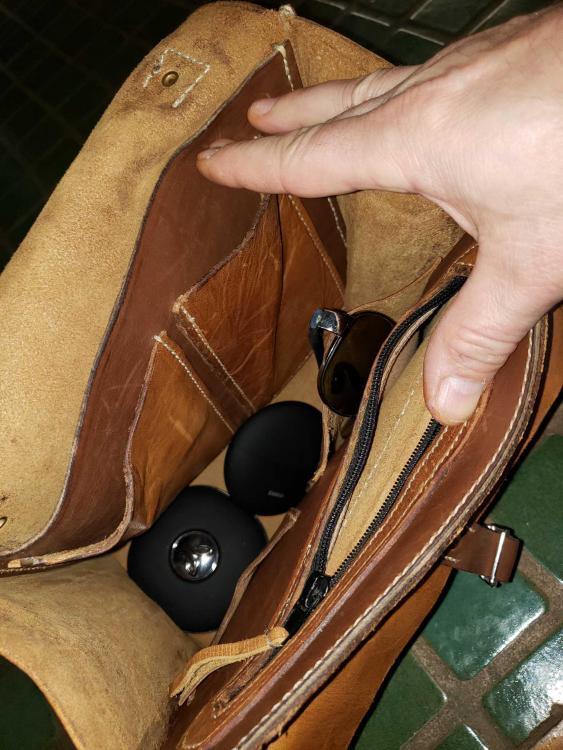
LeatherinCornwall
Members-
Posts
17 -
Joined
-
Last visited
Content Type
Profiles
Forums
Events
Blogs
Gallery
Everything posted by LeatherinCornwall
-
Hey guys, thought I might post a question, while I'm pulling my hair out....my 441 machine was running fine for heavier stuff, I made an effort to dumb it down a bit to fix a couple pairs of the wife's leather boots. It's fairly light leather plus a zipper where I need to sew. So I changed to (I think) 92 thread for top and bottom, installed a 160 needle (smallest I have) and adjusted the tensions and spring per the tutorial here on the forum, and now no matter what I do, regardless of tension settings, I'm getting the top thread making a loop on the underside, on a regular basis, roughly every 3-5 stitches, and usually it snags and breaks the thread. What it generally does, at the start of stitching, while I hold the top thread as usual, it's slack the first 3 stitches, then the machine starts pulling hard on the top thread in my hand, and one or 2 stitches later it bunches up a bit, and pops the thread on the underside. I've adjusted top and bottom tensions till I'm blue in the face. I tried going up a couple sizes of top and bottom thread (192 I think?) and installing a 180 needle, and though it improved, when sewing a double thickness of 3 oz leather, it is still happening.Any thoughts?
-
Sewing external bag seams?
LeatherinCornwall replied to LeatherinCornwall's topic in How Do I Do That?
I keep thinking about that flat edge guide, and feel it still wouldn't work well with really soft leather. I'd think an edge with a flat top which covers over the top of the material an inch or 2, to keep it from bending up, would be just the ticket. -
Sewing external bag seams?
LeatherinCornwall replied to LeatherinCornwall's topic in How Do I Do That?
Here's the similar product sheet for Schmetz needles...which is what I have. Mine are old stock and don't indicate beyond 794, which they are, i.e. DI, S. etc. They are NOS from 1998, so I have no clue which they are. But the stitches I am getting are nice and straight, so I guess they're what I wanted if I can just sew in a straight line :-) leather-needles.pdf -
Sewing external bag seams?
LeatherinCornwall replied to LeatherinCornwall's topic in How Do I Do That?
Tulsa, wow interesting. Who would've thought a needle makes THAT much difference? On the example videos, yeah watched the one, it's a sew and flip inside out type. The Diresta one is new to me, looks like what I need, thanks. Aha watched it, that's exactly how I made the wife's overnight bag, with the overlapped riveted piece at the ends of the opening. Works great. I guess the edge sewing issue is just a training and practice thing. -
Sewing external bag seams?
LeatherinCornwall replied to LeatherinCornwall's topic in How Do I Do That?
At $375 plus shipping that 4-piece set is a bit out of my reach at the moment for occasional use. Though I may make a set from standard cheaper parts. Amazing what one can do with a mig welder and a right angle grinder. My new roller guide like yours above hasn't shipped yet, being Chinese New Year plus Corona delay... -
Sewing external bag seams?
LeatherinCornwall replied to LeatherinCornwall's topic in How Do I Do That?
Hey, thanks for the insight. Yeah, I should have set the stitch length to full, before measuring for that cutout, I'll check and readjust later today. Head up my keester at times. Wow, if I could knock these out in a day, that would potentially be profitable. First one took like 30 hours with all hand stitching, the last one like 16-18 with partial hand work. I've got the advantage of using Autocad for pattern design, my day job requires the skill already for building design, so on that end, designing new projects is easy and quick. I will look into a left foot setup, would like to see what you come up with on your end. I don't care much for the flat plate without a feed dog, the stitching thus far I've found to be unpredictable in length at times. But it's all still new to me, maybe that can be sorted out. Is there a pic of a flat edge guide on here somewhere? Interested... -
Sewing external bag seams?
LeatherinCornwall replied to LeatherinCornwall's topic in How Do I Do That?
For an edge guide, though I ordered one, it's not here yet. And I don't think it could be used here. The leather is too soft. I simply scribe a straight line and follow it by eye. The line actually goes all curved on the machine, I just realign to follow it, and end up with a super straight line afterwards. The material is just too flimsy to follow an edge or even stay straight resting on the curved needle plate. That's where this inline setup helps...the narrow center foot and hidden rear foot maximize the seam visibility...just gotta center the scribed line on the hole in the front foot. This new machine is freaking amazing. I ran through all the factory tuning to ensure it's dead on, I think it's right now. Still not fond of the look of the back stitching, so I just leave enough thread to tie the ends off under the seams, looks neatest. I'm still a beginner. I'm sure there are better ways to get there, but so far this works for me. The first machine I had was a SailRite clone, and the POS would skip stitches, lose its timing, etc. if you looked at it wrong, despite setting all the timings and adjustments perfectly. Just couldn't handle changes in thickness or any variations in the work without hiccupping. Sold it. This 441 clone just carries on. Had a get together with friends last eve, showed off this bag, and had like 4 or 5 commission requests, between this one and the 2 others I made, they're interested. These dang things just take too much time to make any money compared to the day job. What's a bag like this even worth, on a commission scale anyway? $300 maybe? $400? I have like 20 - 22 hours in this last one. -
Sewing external bag seams?
LeatherinCornwall replied to LeatherinCornwall's topic in How Do I Do That?
-
Sewing external bag seams?
LeatherinCornwall replied to LeatherinCornwall's topic in How Do I Do That?
This is the presser foot combo I find works the best so far. I made this set from a stock larger fork style, as they're cheap to buy. Just narrowed the center foot, and cut up a fork, welded a foot in line behind the center foot, for an inline set. Works a treat. However also, you can see in the photo, the stock needle plate slot is huge, and I welded the rear portion shut, that resides under the rear foot, as the feed dog doesn't travel that far. Works a treat. For a machine drive, I used a cheap Chinese servo motor, and installed an oil filled gear box drive picked up on Ebay for a few bucks, reduces it by 3.8 to 1. Now I can stitch so slow I can almost go get a cup of coffee waiting for the needle to come around again lol.... -
Sewing external bag seams?
LeatherinCornwall replied to LeatherinCornwall's topic in How Do I Do That?
Latest bag, completed yesterday. I'm figuring out the machine. Some of this is obviously hand sewn, the outer stitching and some other work is with the machine. I don;t think people can tell the difference, unless the stitching gets sloppy crooked. -
Sewing external bag seams?
LeatherinCornwall replied to LeatherinCornwall's topic in How Do I Do That?
toxo, my issue is making a straight and neat stitch evenly around the overlapped outside seam, given the odd shape, and especially around the corners where the curve area is most difficult. -
Sewing external bag seams?
LeatherinCornwall replied to LeatherinCornwall's topic in How Do I Do That?
Dwight, thanks for the reply. I guess getting the holes in the right place is the whole issue for me. The stitching looks fine if the machine is set right and done super straight. You actually have to look closely to tell them apart. But only if I can get a straight line of holes punched with the machine in the first place. Have been practicing, seems that if I scribe a typical edge groove, as is done for hand stitching, it gives a good line for the needle to follow, and sewn at super slow speed, seems to work out well. Unless the bobbin empties...or tension goes haywire due to an errant snag somewhere, lol.... -
Sewing external bag seams?
LeatherinCornwall replied to LeatherinCornwall's topic in How Do I Do That?
Yeah, thanks I saw that post. I don;t mind the back side look. If tension is set correctly, it looks fine to me. I just want reliable straight sewing on the edge. It's sounding more and more like I'm off in the weeds here. -
Sewing external bag seams?
LeatherinCornwall replied to LeatherinCornwall's topic in How Do I Do That?
I did buy the raised needle plate for doing harnesses, etc. I imagine that's along the lines of what you're thinking. I did try that, however it requires removal of the feed dog, which then makes stitch length unreliable. -
Sewing external bag seams?
LeatherinCornwall replied to LeatherinCornwall's topic in How Do I Do That?
Sure, I realize that. But I just want a fighting chance to make stitches appear straight and even across an external seam. Doesn't have to look exactly like hand sewn. -
I've been making leather satchels, backpacks and messenger bags, and it seems people are turned off by standard inside-flipped seams (sew and flip inside-out) when they see my external seam work. I've been doing those hand sewn, but it's so time consuming. I've bought a Juki 441 clone for my leather work, and am trying to figure out the best way, and best presser foot/needle plate combo to make the best, straightest visible seams possible. Youtube search yield nothing, I gather that people can't do it well enough, or they'd post a video. I know I can't exactly duplicate the look of straight hand-sewn work, but want to get close. Any thoughts on experience with this? Any help is most appreciated.






